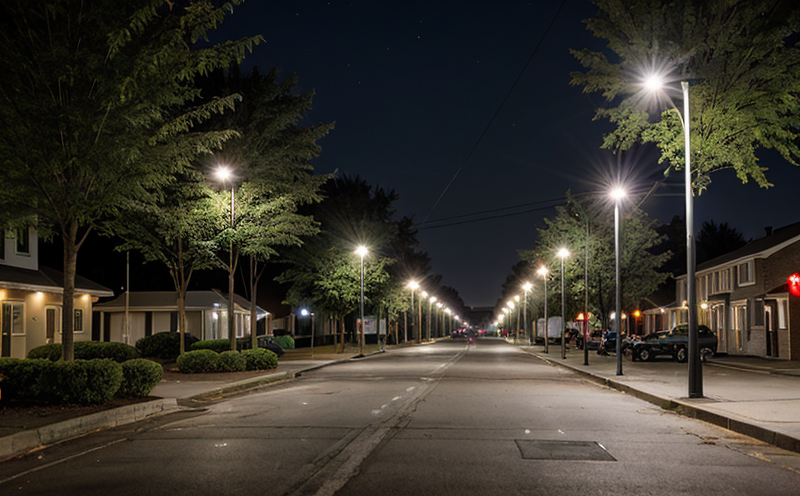EN 50507 Emergency Outdoor Lighting Testing of Exit Routes
The European standard EN 50507 is a crucial document that specifies the requirements for emergency lighting in outdoor and exit routes. This standard ensures that emergency lighting systems are capable of providing adequate illumination during power outages or other emergencies, thus safeguarding public safety. The testing procedure outlined in this standard involves rigorous checks on light output, duration, and uniformity to ensure compliance with international standards.
EN 50507 is particularly important for facilities like commercial buildings, industrial complexes, and public spaces where emergency lighting plays a vital role in ensuring the safe evacuation of occupants. The testing process typically includes multiple stages, each designed to evaluate different aspects of the system's performance under emergency conditions.
The first stage involves verifying that the emergency lighting fixtures are correctly connected and powered by an independent source such as a battery or UPS (Uninterruptible Power Supply). This step ensures that the system can function independently when the main power supply fails. The second stage focuses on measuring the light output, which must meet specific luminance levels to ensure visibility for pedestrians and vehicles. The third stage evaluates the duration of the emergency lighting, ensuring it remains operational for at least 90 minutes as per EN 50507 requirements.
The fourth stage checks the uniformity of the light distribution across the exit route. This is critical because uneven illumination can lead to blind spots that hinder safe evacuation. In this context, Eurolab uses advanced photometric instruments such as integrating spheres and high-precision photometers to measure light levels accurately.
For quality managers and compliance officers overseeing these projects, it's essential to understand the implications of non-compliance with EN 50507. Failure to meet these stringent requirements can lead to legal penalties, fines, and most importantly, compromised public safety. Ensuring that your emergency lighting systems are tested according to this standard is a proactive step towards maintaining compliance and enhancing safety standards.
From an engineering perspective, R&D teams benefit greatly from such testing protocols as they provide real-world data on system performance under various conditions. This information can be invaluable for refining designs, improving efficiency, and identifying potential areas of improvement. For procurement professionals, knowing the specific requirements outlined in EN 50507 helps in selecting reliable suppliers who adhere to these standards.
The testing process is not merely a formality but a critical component of ensuring public safety. By adhering to this standard, organizations demonstrate their commitment to maintaining high-quality infrastructure that can withstand emergencies without compromising on performance or reliability.
Benefits
Testing emergency outdoor lighting systems according to EN 50507 offers several significant benefits:
- Enhanced Safety: Ensures that emergency lighting functions effectively during critical situations, thereby enhancing overall safety standards.
- Compliance Assurance: Helps organizations comply with international regulations and avoid legal penalties associated with non-compliance.
- Risk Mitigation: Reduces risks related to potential failures of the lighting system in emergencies, which could lead to accidents or injuries.
- Predictable Performance: Provides reliable data on how well the emergency lighting systems perform under various conditions, allowing for better planning and resource allocation.
In summary, EN 50507 testing is an indispensable part of maintaining high standards of safety and compliance in outdoor and exit route lighting systems. It ensures that these crucial components work as expected when they are needed most.
Eurolab Advantages
At Eurolab, we pride ourselves on providing comprehensive testing services for emergency outdoor lighting systems compliant with EN 50507. Our expertise lies in delivering accurate, reliable results that meet or exceed industry standards.
- Advanced Equipment: We utilize state-of-the-art photometric instruments such as integrating spheres and high-precision photometers to ensure precise measurements of light output.
- Experienced Professionals: Our team comprises highly skilled engineers with extensive experience in lighting testing who understand the nuances of EN 50507 requirements.
- Customized Solutions: We offer tailored testing services that cater to the unique needs of your facility, ensuring optimal performance and compliance.
- Rapid Turnaround: Our efficient processes allow us to deliver quick results without compromising on accuracy or thoroughness.
By partnering with Eurolab for EN 50507 testing, you can be confident that your emergency lighting systems are fully compliant and ready to perform when needed. With our commitment to excellence and rigorous testing protocols, we help ensure the highest levels of safety and reliability in your facility.
Environmental and Sustainability Contributions
The testing procedures prescribed by EN 50507 not only enhance public safety but also contribute positively to environmental sustainability. By ensuring that emergency lighting systems operate efficiently, these tests help minimize energy consumption during non-emergency periods. This efficiency translates into reduced carbon footprints for facilities adhering to this standard.
Moreover, the accurate measurement and regulation of light output according to EN 50507 specifications prevent unnecessary illumination, which is a significant contributor to light pollution. Light pollution has been linked to various ecological issues including disruption of natural ecosystems and increased energy consumption. By mitigating these effects, organizations that comply with EN 50507 standards play an important role in promoting sustainable lighting practices.
Additionally, the durability and longevity ensured by proper testing contribute to waste reduction. Efficient systems last longer, reducing the frequency of replacements and maintenance, which ultimately results in lower environmental impact. In summary, compliance with EN 50507 is not just about meeting regulatory requirements; it's also a step towards fostering a more sustainable future.





